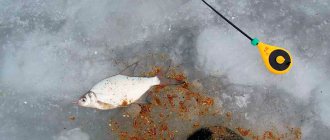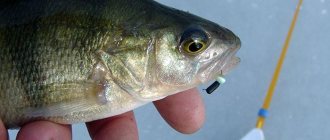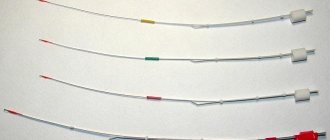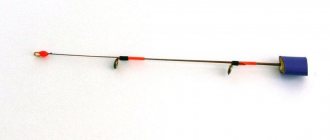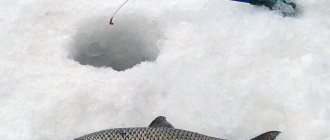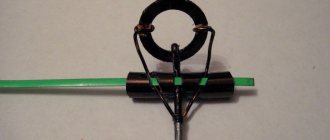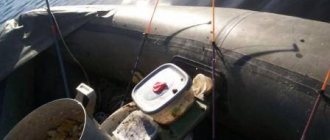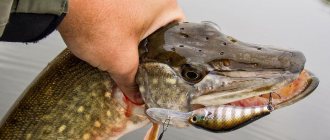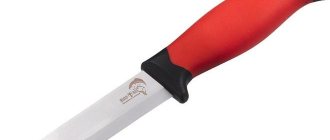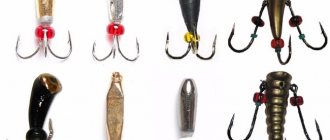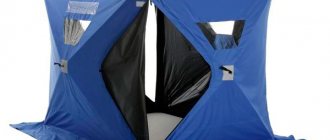Varieties of winter guards for baitless
A reelless tackle is simply a metal ball with a hook. To attract the attention of a fish, it must move in a special way, and in different ways for different fish. The movement will provide a flexible, well-chosen nod, especially in skillful hands. But even a beginner can successfully fish with a reelless bait if he follows the recommendations from our article. How not to get lost in the sea of varieties of nods and choose the right one?
Manufacturing materials
A variety of materials are used for nods; each has its own pros and cons, as well as its own specific tasks. They behave differently at sub-zero temperatures and wind loads, so when choosing a material you need to focus on the characteristics of a particular type of fishing. The location, weather conditions and the type of fish you will be hunting all need to be taken into account to make the right choice.
- Igor Ukolov , a famous master of reelless tackle, offers not only his own jigs, but also nods. Based on personal experience, he can recommend the nod that is most suitable for a particular task.
Carbon gatehouse
Carbon, or carbon fiber, is a modern material with high elasticity and light weight.
It is popular among fishermen for its qualities. Carbon fiber nods so accurately convey the vibrations of the jig that the play of the tackle can be felt in the hand.
In addition, such nods are durable and resistant even to strong winds.
Fluorocarbon
In fishing gear, fluorocarbon is used to make fishing line. Due to its properties, it is almost invisible in water, does not absorb moisture and is very durable. Before modern materials became widely available, fishermen made lodges from boar bristles. In terms of its properties, a guard made of fishing line replaces bristles and is almost unaffected by wind due to its small cross-section. This nod is used only with a light-weight jig, but it makes it possible to play smoothly with high frequency.
Kevlar
Like fluorocarbon, Kevlar is presented on the market in the form of a thread, so the nod from it is made into a spring or loop version. Durable, lightweight synthetic thread is resistant to temperature influences, does not tear, fray or stretch. Spring nods made of Kevlar are reliable and are successfully used in winter. When making your own, it is important to choose the correct thread thickness. However, more often Kevlar is still used for leashes.
Metal
Metal has such important properties as working under a heavy nozzle and in strong winds. A metal nod is useful when hunting fish that require smooth play at great depths or live in strong currents. Various versions of metal nods are sold in stores; you can make it yourself from an old clock spring, wire and other suitable materials.
Ilya Vasiliev makes custom nods from cold-rolled steel ; they are called “Swallow’s Wing” . They are distinguished by the hardness of the material, which does not lose flexibility, due to which they are not subject to deformation due to frequent bending, and withstand the effects of wind and sub-zero temperatures well.
The thickness of the material determines the rigidity of the nod; to change it you will have to work with a file. Metal gatehouses are susceptible to rust, which can significantly shorten their service life. Stainless steel can be used, but it is more expensive.
- Andrey Pukhov makes his own double-cone nods , each hand-made from spring stainless steel. They perfectly show even the most cautious bite. These lodges have earned excellent reviews from fishermen without reeling.
Vladimir Zuev: “I have already tried Pukhov’s nods on several fishing trips, with their help I reproduced small-amplitude play, and achieved good results using the devil.”
Other fishermen also note that fast, small shots are achieved best with these nods.
A fast formation is also noted, in which only the upper third of the guard gives a bend. It’s easy to play with the tip, smoothing out the flaws in the rhythm. Fans of baitless fishing are recommended to try Andrei Pukhov's nods in action.
Lavsan
- Master Alexander Zaitsev makes high-quality nods from a special X-ray film ; they are not afraid of frost and retain their properties at any temperature. They work best in combination with the master's original jigs.
In winter conditions, their plastic nods are in greatest demand.
Stores offer a wide selection in different modifications. It is easy to make a plastic nod yourself; you will need old bottles for this.
The versatility of lavsan nods allows them to carry out a variety of types of games and attract different types of fish.
Plastic nods are easy to process; to change their density, simply sand them or use a razor blade.
They are easy to set up on site.
- The manufacturer “Fisherman Talisman” offers a good selection of mylar nods. By constantly improving its range, the company can satisfy almost any request. When purchasing, you can rely on recommendations for selecting the size of the jig for a specific nod.
Combined gatehouses
According to the name, such nods are made by combining different materials. Metal and plastic are usually used; springs are more common in the system. Thanks to this design, the combined guard will allow for small or smooth play, making it frequent or calm. Wind resistance is an important plus. However, in terms of versatility they are inferior to other types of materials.
Making a spring from several materials requires some skill, so beginners are better off turning to the options offered in stores. It's always a good idea to have a few nods of this species in stock.
Reference! The “Fisherman Talisman” company offers a “Stiletto” spring-type nod model. It allows you to carry out high-frequency, low-amplitude playing, and conveniently perform jump-like wiring. These technologically advanced nods, even in the hands of a beginner, will attract trophy prey.
Types of bite alarms
The classification of gatehouses is made according to the rigidity of the material and length . Let's look at the types of nods for a rewinder in terms of rigidity :
- Soft. The condition for their use is the absence of current into the reservoir and the use of light tackle. Any fish can be caught.
- Average. They are used in almost the same conditions as soft ones.
- Tough. This type will be needed in windy weather and in a body of water with a fast current.
Important! The rigidity of the nod can be reduced by grinding off the “excess” material to the required thickness. The easiest way to make this adjustment is with lavsan.
The classification according to the length of the gatehouses is as follows:
- Short. The shorter the length, the easier it is to carry out high-frequency play with a heavy jig.
- Long. They are used for frequency play with light jigs, which are used more often.
Important! The length of the nod can be adjusted depending on the specific fishing task. This is done using special fasteners.
Types of nods
The initial bend of the nod dictates the creation of the following classification:
- Direct nod. Designed for shallow depths. Hard. The fishing rod with it must be held horizontally.
- Downward curved nod. It has a conical section in one plane, used for fishing at medium depths.
- Curved upward nod. Usually made of metal, when the jig is immersed in water, it straightens into a straight line.
- “Snot.” This is an overloaded guard, used for fishing at great depths, a spring is more often used.
The shape of the nods is divided as follows:
- Simple cone. Wide at the base and tapered at the end, usually made of lavsan.
- Double cone. It has a conical cross-section in two projections and is made of metal.
Important! Double-cone nods are made by master Andrey Petukhov. All of them are hand-bred, made of stainless steel and exhibit excellent wind resistance. They allow you to carry out any type of game on any type of fish, and are sensitive to the work of the fisherman and to the bite.
Other types of gatehouses:
- Sports. Designed for fast, effective fishing, therefore it is made as weightless and sensitive as possible from lavsan film.
- Side. The principles of operation are no different from a straight nod. The main advantage is that it is easier to observe, especially while in a tent. The lateral position, especially in skillful hands, does not affect the quality of the game.
How to choose and set up a nozzle guard correctly? Selection of basic parameters
As with any other method of fishing, when working with a reelless reel, the most important thing is to select the right balance between the weight of the tackle and the quality of the nod. All external factors must be taken into account: the characteristics of the reservoir, the depth and speed of the current, and the wind speed. The type of jig depends on the type of fish you will be hunting, and the nod is selected to match the entire tackle assembly. Stages of selecting a guard for a mothless moth:
- Initially, it is necessary to decide what type of fish will be in the catch, determine the preferred nature of the game for it, and the characteristics of its winter bite.
- A nod of 10-15 centimeters will provide high-frequency play at a depth of up to 5 meters. Greater depth will require a shorter nod.
- When immersed in water, the nod must take a certain bend. The classic angle is 30-45 degrees, but some types of play require a different bend.
- You can adjust the angle of inclination by simply unbending the guard plate in the desired direction.
- An upward bend makes the game slow, but with a large amplitude; a downward bend creates high-frequency vibrations.
It is necessary to note the features of such bait as a nail ball , which consists of a dark column and a colored ball that attracts fish.
This tackle is popular among beginners because it forgives many mistakes in the game. The nod is selected for the weight of the nail ball in the same way as for other types of jigs. Of interest is this type of winter tackle called a garland, when several jigs are tied to a fishing line one above the other, for a total of about five. The number of jigs determines the strength of the guard, so it is better to use a metal one about 15 centimeters long.
Important! When choosing a nod in the store, immediately select a jig for it, but take into account that in water the bend will be slightly less than in the air.
How to set up a gatekeeper?
The choice of nod and all the equipment depends on the fish that you will catch, and therefore, determining the game strategy.
- White fish will require smooth low-frequency play, calm rises and falls, and stops. It is better to take a lavsan or metal nod.
- The predator bites on active high-frequency play with sudden changes in direction . A short lavsan nod would be better.
- For bottom fishing, you need a nod that is sensitive to bites, but can withstand tension. Take metal or hard lavsan.
- For predators such as perch, pike perch or grayling, it is better to make an angle of 5-10 degrees.
- Whitefish, smelt or crucian carp will bite better when the nod is bent at 20-30 degrees.
- Fish that bite from the bottom, such as bream, carp and carp, will require a bend of 30-40 degrees.
Reference! Please note that different species of fish require different guard sensitivity and angle of inclination.
A metal double-cone nod works well when fishing for devils , it is characterized by increased sensitivity, but also holds weight at depth. The upper third of the nod works, so it is best suited for high-frequency playing. The downside is that such a nod must be ideally matched to the weight of the jig; manual finishing can ruin the taper, so it’s better not to take risks. You can rely on the manufacturer's recommendations for the size of the jig.
Important! The length of the nod should be adjusted to the depth of the reservoir; the deeper, the shorter.
Let's talk about this type of baitless bait called “microbalda”. It works universally with different types of fish and in different conditions. Having developed from the classic “bullshit”, it has lost in size, but not in quality of catch. This tackle requires an active leash, for which it will be convenient to use a spiral nod made of fishing line about 10-15 millimeters long. Take a sensitive lavsan nod measuring 10-20 millimeters.
About nods and nozzles
It is not a revelation to anyone that for successful fishing with baitless jigs, the main condition is a high-quality action of the bait. A jig with an attachment is more democratic in this regard; fish can bite both on standing tackle and on arbitrary swings.
In turn, this is ensured by the correct construction of the entire tackle, in which, in addition to the jig itself, the main element is the nod. For the manufacture of nods, two main materials are now used - lavsan and spring steels. Based on my experience, there are no significant differences between them, however, lavsan is a little softer, so it doesn’t bounce back as much.
For normal play, you need to choose the right weight of the jig for a certain nod. Ideally, for a rewinder, the nod should either continue the axis of the whip, or deviate downward no more than 10-20 degrees from the axis. With a pencil grip of the fishing rod (when you hold it with two fingers, like a pencil or pen), it is easy to imagine that you are drawing. In fact, one of the techniques for learning to play is based on this: the fisherman mentally imagines a writing instrument in his hand and quickly “draws” short vertical lines on imaginary paper in a given range. I myself studied according to this scheme. There is one “but” here: this setup of the tackle does not forgive mistakes in the game, sensitively reacting to any failure. But it allows you to clearly convey any movement of the fishing rod to the bait, and work with different amplitudes and frequencies. This scheme can be recommended to fairly experienced fishermen who have learned the basics of baitless fishing.
The second option for the “jig – nod” combination, when the tackle is somewhat overloaded. The nod deviates from the axis of the whip by 40 degrees or more. This weight distribution is not so sensitive to the angler’s manipulations, but “forgives” flaws in the game. Often on reservoirs you can see very sweeping play with a fishing rod. If the tackle had been finely tuned, the jig would perform unimaginable pirouettes under water and would rather disperse the fish than catch it. But if you look from the outside, you can see that the tip of the overloaded nod makes very small vibrations; its elasticity is not enough for an overweight jig to repeat all the movements of the whip. Oddly enough, such congestion also has its advantages. You can often hear from anglers: I can’t play without glitches at high speed. This is not a rare phenomenon and the point here is not in a person’s skills, but in basic physical capabilities. We are all different, for some long-term, uniform high-frequency oscillations are simply an impossible task due to, for example, age, any injuries, undeveloped fine motor skills, even psychotype. An overloaded nod to a certain extent neutralizes these shortcomings; a heavy jig acts as a damper, extinguishing harsh play. Also, overloaded nods tend to be more sensitive to bites. But to ensure a wide amplitude of the game, you have to nod the jig, but rather toss it, which negatively affects the smoothness.
The worst option is an underloaded nod. In this case, it is not informative, it poorly conveys the touch of the bottom and the fish, and the retrieve is very sharp.
The rigidity of the nods, of course, can be somewhat corrected by moving it in the fastening ring rather than varying the length. But, nevertheless, it is better to initially choose a suitable one, hanging on it in working condition the jig that is supposed to be used for fishing.
We make the right guard for a nozzle with our own hands
Many experienced fishermen are not satisfied with the quality of the guards offered by stores. You can order a nod from a master, or you can make it yourself. Especially considering that most materials are easy to process even for a beginner. Materials that are suitable for making a nod:
- Lavsan or other plastic;
- X-ray film, old floppy disks;
- carbon (carbon fiber);
- fluorocarbon or monofilament fishing line;
- steel plate or clock spring.
Options made of lavsan, carbon and metal can be found in the store, but if made independently, they may be more sensitive and work for a specific task.
Fluorocarbon gatehouse at home
For such a guard, a thick fishing line is taken, which is rolled up into a ring and secured with cambrics. It will be practically insensitive to wind due to its small thickness. You can also make a twisted nod. To do this, a fishing line is tightly wound around a thin metal wire, heated in boiling water, and then removed. The result is a “snot” nod, which remains rigid enough for a heavy bait. Both options need to be painted so that it is clearly visible against the background of snow.
From a floppy disk at home
For micro jigs, disks from old floppy disks are often used.
It turns out to be a good sports nod, but the weight for it also needs to be selected to a minimum. The thinness of the film will ensure the sensitivity of the nod, which is necessary for sports fishing. It must be remembered that a very soft and short nod cannot be used at great depths or in strong currents; it simply will not cope with its task.
From film at home
X-ray film makes it possible to obtain a sensitive nod for a rewinder, which will be resistant to frost and at the same time easy to manufacture. As in the case of a floppy disk, it is only suitable for light jigs, but the result will be successful. In addition to X-ray, you can take film from an old keyboard, but its frost resistance is lower, but the sensitivity will be higher.
Making a carbon bite alarm, step-by-step instructions
Carbon nods are not altered, but are made for one specific game and the weight of the jig .
- Pick up, for example, an old broken fishing rod; a feeder, spinning or float rod will do.
- Split the rod, being careful not to damage the workpiece.
- Using scissors or a utility knife, cut a strip of the required length and width.
- Use sandpaper to give the desired shape.
- Paint the finished part with nail polish.
- Secure the nod using connectors (use casings, insulation of two-core wires and other similar material), and carry out a load test.
Important! Don't forget about carbon toxicity! Be sure to wet the part and tools with water to avoid inhaling carbon fiber dust. In addition, this will speed up the processing process.
Where else can you find carbon fiber at home?
- spokes of an old umbrella;
- aircraft model strips.
The best baitless fishing technique in action
The reelless fishing rod allows you to catch large fish in any weather, but it also requires additional skill and time to master. In addition, physical training will play an important role, because with a reelless fish you need to constantly play; you won’t be able to sit and wait for a bite. You need to choose a reservoir where there are a lot of fish and they behave actively.
Fishing technique
- Before you start fishing, you need to understand the characteristics of the chosen reservoir and determine the location of the fish in it. If you are just starting out, rely on the advice of older comrades.
- You need to prepare a lot of holes and actively move between them; otherwise, it is impossible to achieve an excellent result when fishing without bait.
- Over time, you will develop your own technique, but it makes sense to focus on the basic techniques first.
- Pauses, rhythm, swaying, tapping on the bottom, smooth rises and falls will attract the attention of the fish.
- Often the bite happens when the game changes, so try to improvise.
- Changing the lifting height also works well, lift the jig from the bottom by 15-20 centimeters, then up to half a meter, carry out several such lifts in a row.
Which fish bites which game?
- For perch, a simple game at a constant frequency will be enough, for example, change six vibrations per second to three. Work with heights in the 50 centimeter range, don't be afraid to experiment.
- The game works on the roach with a small amplitude of up to one centimeter.
- Any jig is suitable for bleak, choose a small amplitude of the game.
Simple basic wiring diagram:
- Tap the bottom.
- With slight vibrations, gently lift the jig.
- Slowly lower to the bottom again.
- After a five-second pause, knock again.
- Swinging smoothly, lift the jig.
- At the top, stop for five seconds.
- Carry out a control hook and smoothly lower it, stopping 15 centimeters from the bottom.
- After five seconds, begin your ascent.
- At the top, pause for five seconds.
- Smoothly lower to the bottom and knock.
- Climb to the top at a steady pace.
- A meter from the bottom, pause for five seconds.
- Carry out a control sweep.
- If there is still no bite, move on to the next hole.
How to set up for winter fishing? Correct game.
Let’s set up the “Swallow Wing” for fishing:
- When free, it is bent upward at an angle of 30 degrees.
- Under the weight of the gear, the downward deflection angle should not exceed 20 degrees.
- We put on the jig and see what happens.
- If the nod is bent down too much, it needs to be rolled out.
- This is done using special rollers or with your fingers.
- We move the cambrigs to the ring so that they do not interfere.
- We pinch the strip with our thumb and forefinger, bend it slightly upward and run our fingers along the entire length. Nod straightened slightly. Repeat until the angle of inclination reaches 20 degrees. Do the wiring with a weight on so as not to bend it.
Important! A weak nod does not compensate for the weight of the bait. The fish feels a mass of jig in its mouth and immediately spits it out.
Ready! Now let's go fishing. Reelless fishing is always an experiment.
In the same place, but at different times, the fish bite on different wires.
Therefore, using only one type of game is not promising.
You need to learn how to use different moves, pauses, and game changes. Get the fish interested and make it grab the prey.
The most frequently used games are:
- amplitude;
- high frequency;
- "drunk hands"
Important! To get a big catch, you need to have a supply of different types of jigs with you. The most popular are uralka, ant, shell and devil.
The most catchy tactic is the tactic of non-moth “looting”. It consists of fishing old holes left by other fishermen. For example, after night fishing or in the morning, people came to fish, but did not see a bite and, without waiting for the evening, left their places. In this case, the holes are fed, and you can get a good catch from them.
Fishing technique:
- Wiring must begin from the bottom.
- We use “devil” or “uralka” 0.7–0.9 grams.
- We make five to seven different postings.
- If there are bites, pokes, failures, then it makes sense to fish. If not, then we move on to the next hole.
- So, let's start the game. The jig goes to the bottom, and a smooth swing once or twice. Then a pause. We repeat.
- We change the game - add amplitude. Then we add oscillation frequencies. Pause. Let's move on to "drunk hands".
- The tip of the nod paused slightly, as if someone were holding a fishing line. Sweeping. We throw the fishing rod onto the ice and carefully pull out our catch by the fishing line.
- We repeat the whole process again until we receive moral satisfaction.
Sometimes the echo sounder shows some objects, but there is no bite from the bottom. Perhaps the fish, often bream, are 1–2 meters above the bottom. In this case, you need to play by winding the reel 5 turns each time. We do the wiring in the water column, raising the bait up to three meters. In this way it is possible to catch good bream, while other fishermen have no bites at all.
Side guard for rewinder
A side nod for a winter fishing rod has some advantages over a direct attachment.
- the angler's position can be more ergonomic due to an elongated rod;
- the visibility of bites improves when positioned sideways;
- the game can be low-frequency and high-amplitude;
- control of wiring and cutting remains very high quality;
- When hooking, an elongated rod dampens the jerks of large fish.
The principle of equipping a side fishing rod with a guard is the same as in other cases. Tackle can be used of any weight, up to quite heavy for a large predator. The main thing remains to select the size of the jig according to the properties of the nod and adjust the correct angle of inclination.
Why do you need a nod?
The ability to quickly respond to a bite and control the vibrations of the bait are functions of the nod that increase the chances of a catch.
The nod signals the fisherman about a bite. In winter, fishing gear experiences harsh weather conditions: materials must be resistant to temperature changes, withstand numerous bends and not deform. Requirements that the gatehouse must meet:
- resistance to natural reactions (wind, snow, humidity);
- high wear resistance (to minimize replacement frequency);
- low cost;
- availability of materials for installation;
- the ability to monitor bait wiring.
Making a nod for a winter fishing rod that will suit individual fishing conditions, the size of the prey, and the nature of the bait is not difficult. It is enough to stock up on the necessary materials and show imagination and dexterity.
Catching large perch with devil
In the winter, the devil, and even in skillful hands, will help you get an excellent trophy specimen of perch. The main thing is to actively move and look for a fishing spot.
Since the devil is a large tackle, it needs to be played strictly vertically, without deviations. The leashes should be intermittent, dotted ascents and descents and resemble the movements of an amphipod. This is what perch hunts in winter. The game should be small-amplitude and high-frequency.
Setting up the nod is very important, otherwise you won’t be able to play the game correctly.
It is better to choose lavsan and metal from the materials; it is important that the nod reacts sensitively to the weakest bites on the rise. The shape can be reverse curved or S-shaped. In the working position, the weight of the nod should be about 45 degrees. If you take back the curved nod, it straightens horizontally under the weight of the jig. Techniques for catching perch using devils in winter:
- You need to start attracting fish from afar, the vibrations are strong, at the bottom. Raise and lower the devil to a height of 10 centimeters about seven times.
- Then start the main type of wiring. Dotted rises are accompanied by pauses every 15 centimeters. You need to experiment with amplitude and speed.
- You can improve your technique by sharply changing speed and smoothness.
- If there is no bite, you can try reducing the size of the jig.
- Raising the turbidity on the bottom by tapping will attract the attention of the fish.
- Avoid movements in the horizontal plane!
Useful! An active perch bites on fast chaotic movements; during a period of passivity, it will be attracted by slow vibrations.
Small devils weighing up to 1 gram require a slight nod. Heavy jigs up to 5 grams will need a longer guard. The longer the nod, the easier it is to carry out an amplitude vertical game. But if you are fishing in a body of water with a current, the length of the nod should be reduced.
